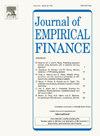高频在线通货膨胀与利率期限结构:来自中国的证据
IF 2.4
2区 经济学
Q2 BUSINESS, FINANCE
引用次数: 0
摘要
在数字时代,网络价格具有价格粘性弱、对经济冲击高度敏感的特点,其信息价值值得更多关注。本文将高频在线通货膨胀率整合到动态Nelson-Siegel (DNS)模型中,探讨其与利率期限结构的关系。实证结果表明,每周在线通货膨胀率显著预测收益率曲线,尤其是斜率因子,而月度官方通货膨胀率不能预测收益率曲线,而是由收益率曲线因子预测。机制分析表明,由于价格粘性较低,在线通货膨胀对短期经济波动更敏感,更能反映货币市场流动性,因此对短期利率和斜率因子具有显著的预测能力。具体而言,非耐用品和工作日的在线通货膨胀对斜率因子显示出更强的预测能力。这些类别之间价格粘性的异质性解释了对收益率曲线的不同影响。本文章由计算机程序翻译,如有差异,请以英文原文为准。
High frequency online inflation and term structure of interest rates: Evidence from China
In the digital era, the information value of online prices, characterized by weak price stickiness and high sensitivity to economic shocks, deserves more attention. This paper integrates the high-frequency online inflation rate into the dynamic Nelson-Siegel (DNS) model to explore its relationship with the term structure of interest rates. The empirical results show that the weekly online inflation significantly predicts the yield curve, especially the slope factor, whereas the monthly official inflation cannot predict the yield curve and is instead predicted by the yield curve factors. The mechanism analysis reveals that, due to low price stickiness, online inflation is more sensitive to short-term economic fluctuations and better reflects money market liquidity, thereby having significant predictive power for short-term interest rates and the slope factor. Specifically, online inflation for non-durable goods and on weekdays shows stronger predictive power for the slope factor. The heterogeneity in price stickiness across these categories explains the varying impacts on the yield curve.
求助全文
通过发布文献求助,成功后即可免费获取论文全文。
去求助
来源期刊

Journal of Empirical Finance
Multiple-
CiteScore
3.40
自引率
3.80%
发文量
59
期刊介绍:
The Journal of Empirical Finance is a financial economics journal whose aim is to publish high quality articles in empirical finance. Empirical finance is interpreted broadly to include any type of empirical work in financial economics, financial econometrics, and also theoretical work with clear empirical implications, even when there is no empirical analysis. The Journal welcomes articles in all fields of finance, such as asset pricing, corporate finance, financial econometrics, banking, international finance, microstructure, behavioural finance, etc. The Editorial Team is willing to take risks on innovative research, controversial papers, and unusual approaches. We are also particularly interested in work produced by young scholars. The composition of the editorial board reflects such goals.
 求助内容:
求助内容: 应助结果提醒方式:
应助结果提醒方式:


